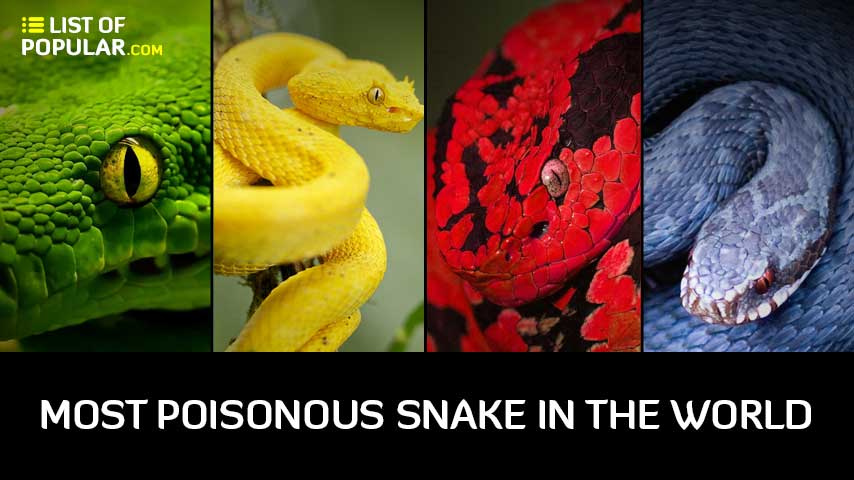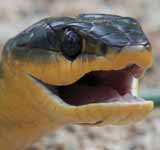A taipan bite from the inside may contain enough poison to kill 125 adults or 253,000 mice. The average delivery of poison is 44 mg, 110 mg is the largest record. Its venom is 200-500 times more toxic than most rattlesnakes and 50 times more toxic than that of a cobra. The poison has neurotoxic action and could potentially kill an adult human in 45 minutes. There is no documented information on human fatalities when the bite was treated with antisera.
2. Black Mamba
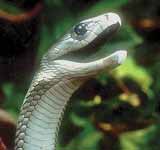
With an average length of 2.5 m, it can reach 4.5 m. It name is due to the black color inside his mouth, being able to vary the color of its skin yellowish green to a metallic gray. It is one of the fastest snakes in the world, capable of moving from 16 to 20 km/h. It weighs an average of 1.6 kilograms and lives approximately 11 years.
3. Dubois' Sea Snake
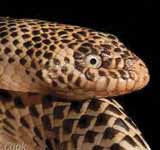
Acute toxicity of solid venom is normally tested in laboratory animals and evaluated for moderate lethal dose (LD50), which means the dose needed to kill half of the members in a test group of individuals is divided by the weight of the test animal. LD50 depends on the animal. They are moderately aggressive, that is, they are countered by the threat of external threats to launch self-defense, rather than spontaneous. The fangs are 1.8 mm long, which is a relatively short snake, and the venom production is 0.44 mg.
4. Black Cobra
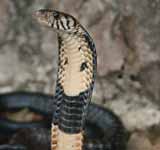
Adult black and white hat snakes reach a length of 150 to 200 centimeters. In exceptional cases, the snake can grow up to 300 centimeters and more. The head lifts off from the rest of the body slightly. He is relatively small for a cobra. In terms of color, the species can vary considerably. The form that occurs in South Africa, for example, is brown to brownish gray, those from West Africa are mostly black. The belly usually has a yellowish or whitish cream-colored color, partly with black spots. The scales are soft and shiny.
5. Eastern Brown Snake
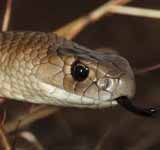
It is found almost all over Australia and can be found in New South Wales, Queensland, the Northern Territories, South Australia, Victoria and Western Australia. Furthermore, the poisonous snake inhabits the north of Australia located New Guinea. The Eastern Brown Snake venom is extremely potent, the LD50 value for mice is 0.041 mg per kilogram of body weight, making it one of the most potent poisons known in snakes.
6. Yellow Bellied Sea Snake
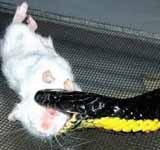
This snake can be distinguished from other sea snakes. Its trademark is his shiny black back and belly which is bright yellow or sometimes sulfur yellow. These scales are small and smooth. The cross section of the body is flat on the abdomen. The tail is flat and has black and yellow patches. The length of the male snake reaches 0.72 meters and the female reaches 0.88 meters. This snake is the most formidable and sturdy body of the sea snake. This is because these snakes are a type of snake that is very active in exploring the vast ocean with different pressures, salts and water currents in each waters region, but this snake cannot live in a sea with very high salinity such as in the Red Sea.
7. Peron's Sea Snake
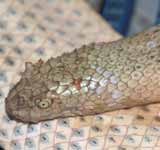
This is a medium sized hose. The diameter of his neck is only one third to two fifths of the diameter of the thickest part of his body. It has a small head size. Its tail has a lateral flattening. Supraocular skins are raised, and their free edges are sharpened. This species reaches the length from the tip of the muzzle to the natural opening of the body, slightly exceeding 1 m. Other sources give size 128 cm. The dorsal surface of the body is colored grayish, slightly yellow or tan, with dark crossings with narrower lines than spaces between them, with a narrowing towards the sides of the body.
8. Coastal Taipan
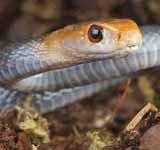
With an LD50 of 0.01 mg/kg, it is 10 times more powerful than Crotalus scutulatus, and 20 times stronger than the cobra. Although there is an antidote, its poison is so lethal that it can cause the death of a human being in a matter of minutes.
9. Caspian Cobra
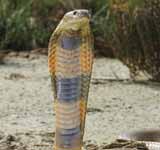
The Caspian cobra is considered the most poisonous of all cobras. Its neurotoxic and cytotoxic poison, in fact, is quite powerful, with a subcutaneous LD50 of 0.45 mg/kg. The snake is able to inject, with a single bite, from 75 to 125 mg of poison, arriving, in exceptional cases, up to 300 mg. The venom initially causes severe pain and swelling in the area of the bite, which then show bruises, blisters and severe or moderate tissue necrosis. Then there are headaches and/or dizziness, nausea and vomiting, abdominal pain, diarrhea, weakness and drowsiness, hypotension, ataxia, paralysis of the throat and/or limbs, convulsions and collapse.
10. Many-banded Krait
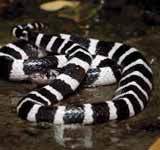
The banded krait reaches a length of 120 to 140 cm. The body is triangular to oval in cross-section and is slim, yet powerfully built. The head is short, flat and barely settling on the neck. The relatively small eye has a round pupil. The body top is covered by 15 rows of smooth scales. Head and body have a shiny black base color. Along the body show 34 to 45 and along the tail another 9 to 16 white to gray-white transverse bands. The ventral side is often darkly spotted.
11. Black-banded Sea Krait

The large flattail, or sea krait is a snake from the sea snake subfamily. The total length reaches 70-80 cm, the maximum length - 170 cm. There is sexual dimorphism - females are larger than males. The color of the upper side of the body is gray or greenish with 30-42 brown transverse bandages, the belly is yellowish in color. The upper lip is brown. The lower part of the maxillary scute is almost equal in length to its width. There is an unpaired shield between the prefrontal plates. Parietal plates contact with the lower postorbital shield. Around the body stretch 21-23 rows of scales. Abdominal scutes - 195-205, subtail tails in females 32-36 pairs, in males - 38-43. He likes slums near the coast. Because of the need to drink fresh water, the snake regularly goes to the land to get drink. Keeps near rocky capes and stone shores, where the striped color masks under the terrain. Active at night. Very poisonous snake, poison highly toxic. It takes fish as food, in particular eels.
12. Black Tiger Snake

The Australian black tiger snake (Notechis scutatus) is a potentially lethal poisonous snake for humans from the coral snake family (Elapidae) and the subfamily Elapinae. It is the only species of the monotypic genus Notechis. The species was first described scientifically by Wilhelm Peters in 1861. For a long time it was included in the genus Hoplocephalus, which means that the obsolete scientific name is used in the literature. The skin color varies greatly per specimen and per season, from gray to light or dark brown or olive, often with narrow, yellow transverse bands. The body length can also vary greatly, and in an adult animal is 100 to 210 cm. This predominantly diurnal terrestrial snake is also sometimes active in the morning and evening twilight, as long as the weather is good. Its food consists mainly of frogs, which it paralyzes with its poison. When he feels threatened, he widens his neck and lifts his fore body.
13. Enhydrina Schistosa

14. Russell's Viper

15. King Cobra

16. Indian Cobra

17. Cape Cobra

The Cape Cobra, like many species of the genus Naja, averages a maximum length of one and a half meters. In the wild, the Cape Cobra is found in South Africa, Lesotho, Botswana and Namibia, preferably on dry land. Like most cobras, Naja nivea possesses a highly toxic bite, being responsible for the largest number of fatalities among snakes in South Africa.
18. Bothrops Asper

19. Gaboon Viper

20. Common Krait


